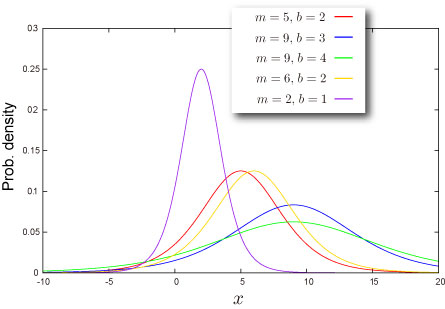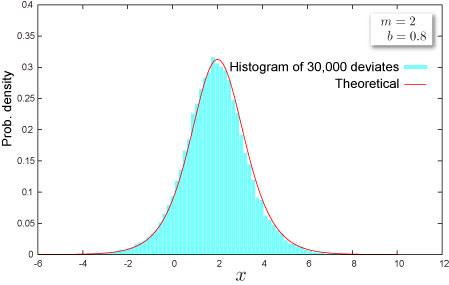Logistic Distribution
Where do you meet this distribution?
- Biology : how species populations grow in competition
- Energy : the diffusion and substitution of primary energy so
- Epidemiology: spreading of epidemics
- Marketing : the diffusion of new-product sales
- Psychology : learning curve
- Technology : to describe how new technologies diffuse and substitute for each other
Shape of Distribution
Basic Properties
-
Two parameters are required (How can you get these).
-
Continuous distribution defined on entire range
-
This distribution is always symmetric.
Probability
-
Cumulative distribution function
-
How to compute these on Excel.
| A | B | |
|---|---|---|
| 1 | Data | Description |
| 2 | 0.5 | Value for which you want the distribution |
| 3 | 8 | Value of parameter M |
| 4 | 2 | Value of parameter B |
| 5 | Formula | Description (Result) |
| 6 | =NTLOGISTICDIST(A2,A3,A4,TRUE) | Cumulative distribution function for the terms above |
| 7 | =NTLOGISTICDIST(A2,A3,A4,FALSE) | Probability density function for the terms above |

- Function reference : NTLOGISTICDIST
Quantile
-
Inverse function of cumulative distribution function
-
How to compute this on Excel.
| A | B | |
|---|---|---|
| 1 | Data | Description |
| 2 | 0.7 | Probability associated with the distribution |
| 3 | 1.7 | Value of parameter M |
| 4 | 0.9 | Value of parameter B |
| 5 | Formula | Description (Result) |
| 6 | =NTLOGISTICINV(A2,A3,A4) | Inverse of the cumulative distribution function for the terms above |
- Function reference : NTLOGISTICINV
Characteristics
Mean -- Where is the "center" of the distribution? (Definition)
- Mean of the distribution is given as
Standard Deviation -- How wide does the distribution spread? (Definition)
-
Variance of the distribution is given as
Standard Deviation is a positive square root of Variance.
-
How to compute this on Excel
| A | B | |
|---|---|---|
| 1 | Data | Description |
| 2 | 2 | Value of parameter B |
| 3 | Formula | Description (Result) |
| 4 | =NTLOGISTICSTDEV(A2) | Standard deviation of the distribution for the terms above |
- Function reference : NTLOGISTICSTDEV
Skewness -- Which side is the distribution distorted into? (Definition)
- Skewness of the distribution is .
Kurtosis -- Sharp or Dull, consequently Fat Tail or Thin Tail (Definition)
- Kurtosis of the distribution is .
Random Numbers
-
Random number x is generated by inverse function method, which is for uniform random U,
-
How to generate random numbers on Excel.
| A | B | |
|---|---|---|
| 1 | Data | Description |
| 2 | 0.5 | Value of parameter M |
| 3 | 0.5 | Value of parameter B |
| 4 | Formula | Description (Result) |
| 5 | =NTRANDLOGISTIC(100,A2,A3) | 100 Logistic deviates based on Mersenne-Twister algorithm for which the parameters above |
Note The formula in the example must be entered as an array formula. After copying the example to a blank worksheet, select the range A5:A104 starting with the formula cell. Press F2, and then press CTRL+SHIFT+ENTER.

NtRand Functions
- If you already have parameters of the distribution
- Generating random numbers based on Mersenne Twister algorithm: NTRANDLOGISTIC
- Computing probability : NTLOGISTICDIST
- Computing mean : NTLOGISTICMEAN
- Computing standard deviation : NTLOGISTICSTDEV
- Computing skewness : NTLOGISTICSKEW
- Computing kurtosis : NTLOGISTICKURT
- Computing moments above at once : NTLOGISTICMOM
- If you know mean and standard deviation of the distribution
- Estimating parameters of the distribution:NTLOGISTICPARAM